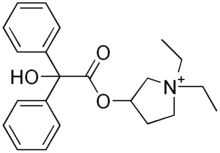Benzilone
Benzilone is an antimuscarinic drug.[1][2]
 | |
| Clinical data | |
|---|---|
| ATC code | |
| Identifiers | |
| |
| CAS Number |
|
| PubChem CID | |
| ChemSpider | |
| UNII | |
| ChEMBL | |
| Chemical and physical data | |
| Formula | C22H28NO3 |
| Molar mass | 354.470 g·mol−1 |
| 3D model (JSmol) | |
| |
| |
| | |
References
- "Benzilone". KEGG database. Retrieved 9 May 2015.
- Schwartz TW, Stenquist B, Olbe L, Stadil F (January 1979). "Synchronous oscillations in the basal secretion of pancreatic-polypeptide and gastric acid. Depression by cholinergic blockade of pancreatic-polypeptide concentrations in plasma". Gastroenterology. 76 (1): 14–9. doi:10.1016/s0016-5085(79)80121-3. PMID 758136.
Benzilonium bromide (Parke, Davis & Co., Detroit Mich.) is a quarternary antimuscarinic agent with minimal passage of the blood-brain barrier.
This article is issued from Wikipedia. The text is licensed under Creative Commons - Attribution - Sharealike. Additional terms may apply for the media files.